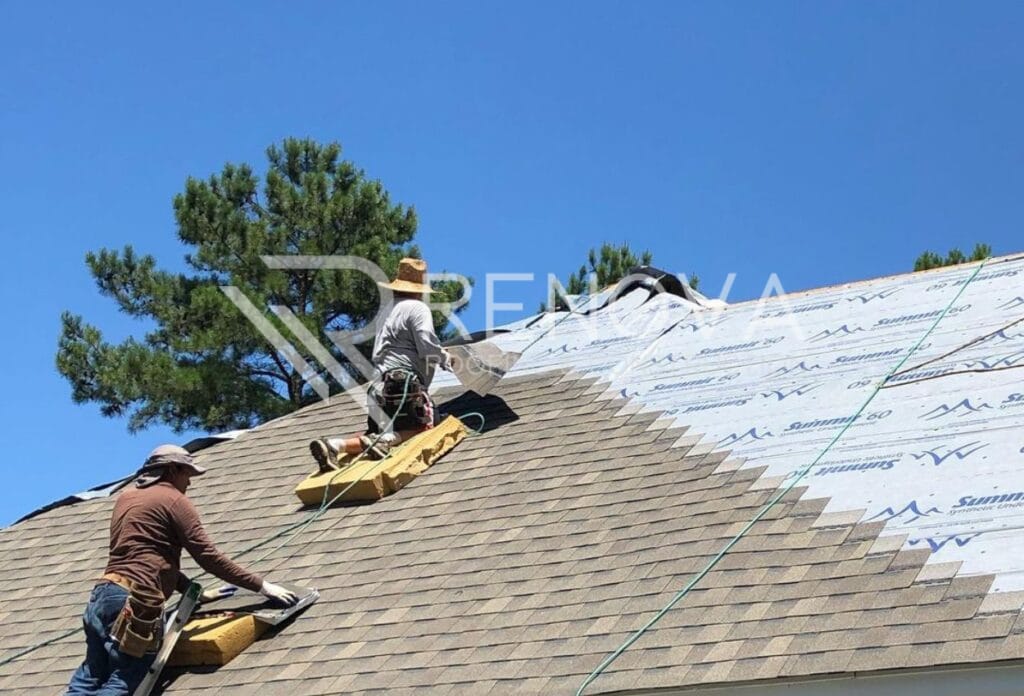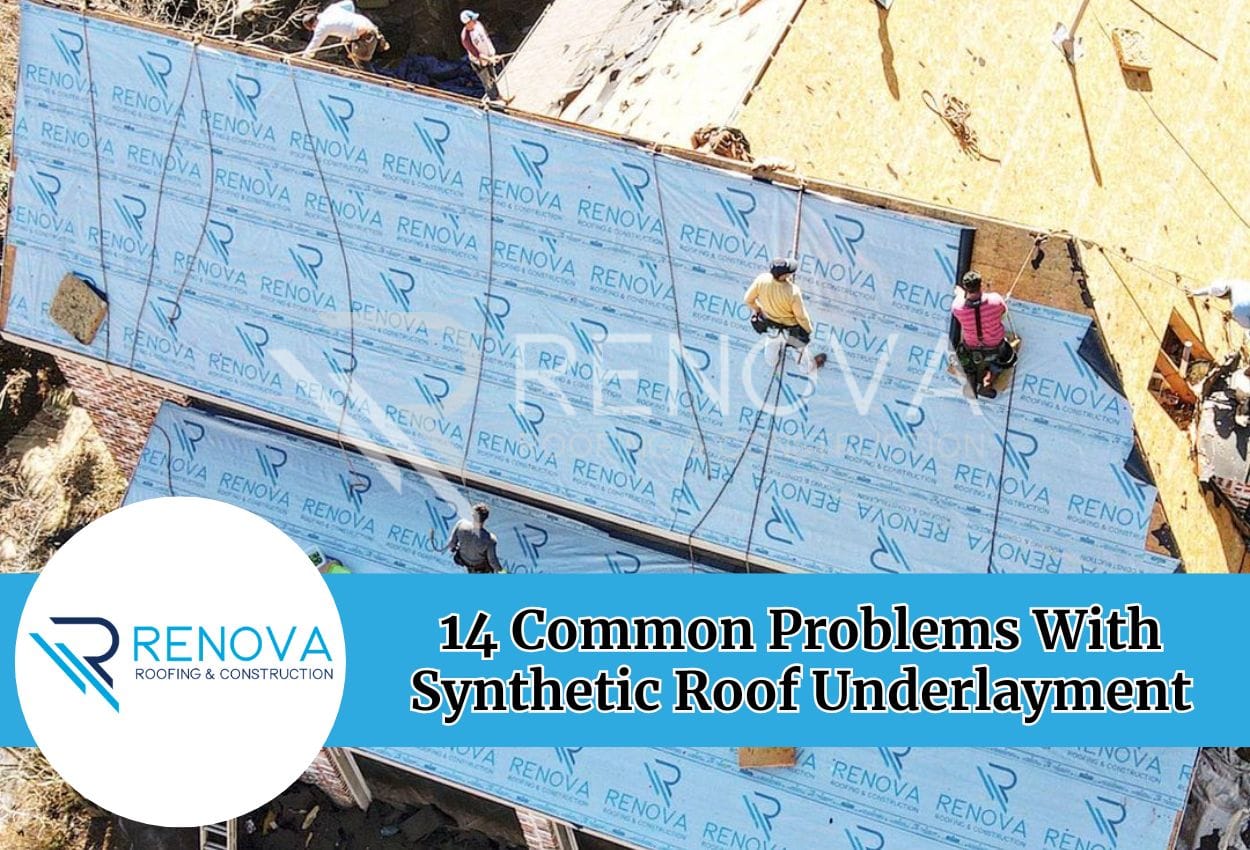With its growing popularity as a modern alternative to traditional felt underlayment, synthetic roof underlayment offers several advantages, including durability, ease of installation, improved weather protection, and resistance to mold and mildew. However, like any product, it also has its drawbacks.
Throughout this blog post, we will help you understand these common problems with synthetic roof underlayment and make informed decisions when planning your roofing project.
What Is Synthetic Roof Underlayment?

A modern substitute for traditional felt, synthetic roof underlayment is renowned for its increased resilience to moisture and longevity. It is lighter than asphalt felt and is composed of polyethylene or polypropylene.
For safer handling, it has a slip-resistant surface and strong tear resistance. Despite being more costly upfront, it is a wise investment for shielding roofs from leaks and environmental harm because of its long-lasting durability and exceptional water resistance.
Also Read: 5 Best Roof Underlayments of 2025
14 Common Problems With Synthetic Roofing Underlayment
Now that you know what synthetic roof underlayment is, let’s take a look at some common issues that homeowners should be aware of:
Problem #1. Higher Initial Costs
Synthetic roof underlayment generally comes with a higher upfront cost compared to traditional asphalt felt. For homeowners and contractors on a tight budget, this can be a deterrent.
However, the initial expense is often balanced out by its long-term advantages, such as increased durability, reduced maintenance needs, and better protection against moisture and damage.
When choosing roofing materials, it’s important to consider the longevity and performance of synthetic underlayment, which can result in significant cost savings over time.
Solutions
- Long-Term Value: While initially pricier, synthetic options like GAF Deck-Armor™ offer durability and longevity, reducing future repair costs.
- Financing Plans: Check for supplier or contractor financing options to spread costs while enjoying immediate benefits.
Problem #2. Slippery Surface Risks
One of the safety concerns with synthetic underlayment is its slippery nature when wet. This increases the risk of slips and falls during installation and maintenance. However, some underlayments come with textured surfaces or granulated finishes, which provide better traction.
Solutions
- Textured Options: Choose slip-resistant products like Owens Corning ProArmor® for better traction.
- Dry Installations: Aim for dry weather installation and use safety gear, such as harnesses and non-slip shoes, when working in damp conditions.
Problem #3. Potential Moisture Trapping
Although synthetic roofing underlayment is designed to repel water, improper installation or inadequate ventilation can result in moisture being trapped beneath it. This moisture can lead to mold growth and wood rot, damaging the roof’s integrity.
Solutions
- Proper Ventilation: Use roof vents and breathable underlayments like Tyvek® Protec™ 120 to allow moisture to escape.
- Follow Instructions: Ensure precise installation with correct overlaps and sealing to prevent water buildup.
Problem #4. UV Exposure Vulnerability
Synthetic roof underlayment is susceptible to degradation from prolonged exposure to UV rays, which can cause it to become brittle over time. This reduces its effectiveness in protecting the roof. Always follow the manufacturer’s guidelines for how long the underlayment can be exposed, typically up to six months.
Solutions
- Quick Coverage: Cover underlayment promptly with roofing materials. For delays, use UV-resistant options like Owens Corning Titanium® PSU30, which can be left exposed for up to 180 days.
- Protective Tarps: If immediate coverage isn’t feasible, consider shielding exposed areas with tarps.
Problem #5. Compatibility Issues with Roofing Materials
Not all synthetic roofing underlayments are compatible with every roofing material. Using incompatible underlayments can lead to adhesion problems, affecting the performance of the entire roofing system.
Solutions
- Check Guidelines: Refer to manufacturer specs to ensure compatibility before starting installation.
- Small-Scale Tests: Test adhesion on a small section before full installation.
Problem #6. Poor Durability (Loss of VOCs)
Some synthetic roofing underlayments may suffer from a loss of volatile organic compounds (VOCs) over time, which can weaken the material and make it more prone to moisture absorption. This is particularly problematic in hot, humid climates.
Solutions
- Choose High-Quality Brands: Options like FT Synthetics FT Silver resist VOC loss and maintain strength.
- Proper Storage: Store materials in cool, dry areas to prevent premature degradation.
Problem #7. Limited Temperature Tolerance
Extreme temperatures can affect synthetic roofing underlayment, causing it to crack or blister in high heat and become brittle in cold weather. These temperature fluctuations can weaken fasteners and seams, compromising the roofing system. Selecting underlayments suited for specific temperature ranges and ensuring proper installation can help prevent such issues.
Solutions
- Temperature-Rated Products: Use high-temperature-resistant options like Owens Corning Titanium synthetic underlayment.
- Monitor Weather: Schedule installation during moderate weather.
Problem #8. Installation Challenges
Improper installation can result in tears, wrinkles, or failure of the synthetic underlayment, threatening the integrity of the roof. Following manufacturer guidelines strictly for fastening and spacing is essential to ensure a secure fit and prevent sagging or movement during installation.
Solutions
- Hire Professionals: Opt for certified contractors, especially those with prior expertise handling synthetic roof underlayment.
- DIY Resources: Use installation guides and videos from manufacturers like Owens Corning or CertainTeed.
Problem #9. Lack of Insulation Properties
Synthetic roof underlayment offers less insulation compared to felt. While felt provides some thermal resistance, synthetic options don’t contribute much to temperature control because the material is thinner.
Solutions
- Add Insulation: Always add foam board or spray foam insulation beneath the synthetic underlayment for better thermal performance.
- Choose Insulated Systems: Look for roofing systems with built-in insulation to improve energy efficiency.
- Explore Alternatives: If insulation is crucial, consider other underlayment options with better thermal resistance.
Problem #10. Increased Maintenance Needs
Despite its durability, synthetic roofing underlayment may require more frequent inspections due to its sensitivity to environmental factors like UV exposure and moisture trapping.
Solutions
- Regular Inspections: Conduct biannual checks in spring and fall to identify potential problems early and ensure the roof’s longevity
- Moisture Sensors: Install attic sensors to detect rising humidity levels.
Problem #11. Warranty Limitations
Many synthetic roofing underlayment manufacturers offer warranties, but these warranties often come with strict conditions, including proper installation and material compatibility. Failure to meet these conditions could void the warranty, leaving homeowners with unexpected costs for repairs.
Solutions
- Review Terms: Understand warranty conditions from the brand, like GAF or CertainTeed.
- Document Processes: Keep records of installation for future claims.
Problem #12. Difficulties in Repairing Damage
If synthetic underlayment becomes damaged, repairing it can be challenging and may require replacing large sections of material due to its design. This can lead to higher labor costs and longer project timelines.
Solutions
- Keep Extra Materials: Have spare rolls for quick repairs.
- Professional Repairs: Hire experts familiar with your underlayment brand for efficient fixes.
Problem #13. Incompatibility with Certain Fasteners
Some fasteners may not be compatible with synthetic roofing underlayment, potentially causing leaks or failure at attachment points. Ensuring the right fasteners are used is critical for maintaining the integrity of the roof.
Solutions
- Recommended Fasteners: Follow manufacturer guidelines for fasteners.
- Test Fasteners: Conduct small tests to ensure compatibility.
Problem #14. Limited Availability in Certain Regions
Depending on the location, some homeowners may struggle to find high-quality synthetic underlayment in their area. This can delay projects or force homeowners to choose less ideal options.
Solutions
- Local Research: Work with a local roofing contractor to find nearby suppliers.
- Online Ordering: Consider ordering from reputable online suppliers for wider access.
Alternatives To Synthetic Roof Underlayment
If you aren’t sure that synthetic roofing underlayment is the right option for you, here are some other options that you can go for:
1. Asphalt-Saturated Felt Underlayment
A traditional choice, asphalt-saturated felt, or tar paper, is made from organic materials saturated with asphalt. It offers good moisture resistance at a low cost but is heavier and harder to install. Over time, heat and moisture exposure can cause wrinkling and water absorption.
2. Rubberized Asphalt Underlayment
For superior waterproofing, rubberized asphalt blends asphalt with rubber polymers, creating a flexible, durable barrier. It’s ideal for areas with heavy rain or snow but comes with a higher price and often requires professional installation due to its complexity.
3. Fiberglass Reinforced Felt Underlayment
Combining felt with fiberglass strands, this underlayment is stronger and more tear-resistant than standard felt. It’s effective as a moisture barrier but doesn’t offer the same waterproofing as synthetic or rubberized options, making it a balanced middle ground.
Get Expert Solutions for Synthetic Underlayment Problems from Rеnova Roofing & Construction
Although synthetic roof underlayment may come with challenges that require attention, homeowners can improve their roof’s durability and performance through proper installation, the use of high-quality materials, and regular maintenance.
For all of your roofing requirements, Renova Roofing & Construction is the company to trust. From roof installation to repair and upkeep, our team takes care of everything, including installing a high-quality underlayment to provide protection and longevity. Whether it’s a metal roof or classic shingles, we produce aesthetically pleasing, long-lasting results. To get the best roofing services, call us at (601) 647-3433!

